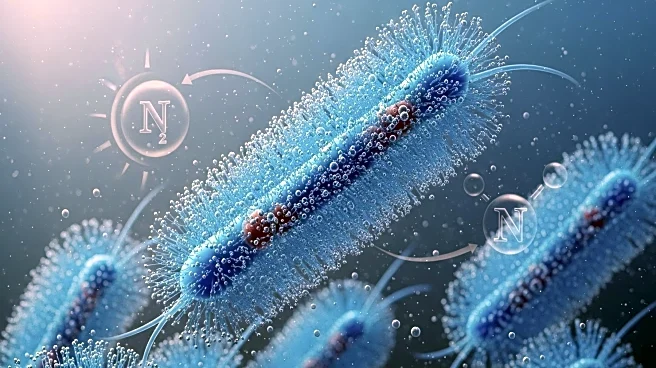What's Happening?
A recent study has conducted a proteomic analysis on Crocosphaera subtropica, a unicellular cyanobacterium, to understand its metabolic adaptations during light-dark cycles and nitrogen fixation. The research involved growing cultures in ASP2 medium with and without nitrate, under continuous light and alternating light-dark cycles. The study identified 2,688 proteins, representing approximately 40% of the proteome, with significant changes observed in proteins related to nitrogen fixation, photosynthesis, and respiration. The presence of nitrate was found to exert a more pronounced influence on the proteome compared to light-dark cycles. Nitrogenases were highly upregulated in the dark under nitrogen-fixing conditions, while proteins involved in photosynthesis and carbon dioxide fixation showed varied responses depending on the presence of nitrate and light conditions.
Why It's Important?
Understanding the metabolic adaptations of cyanobacteria during nitrogen fixation and light-dark cycles is crucial for advancing knowledge in fields such as bioenergy and sustainable agriculture. Cyanobacteria play a significant role in nitrogen fixation, a process essential for soil fertility and plant growth. Insights into their metabolic processes can inform strategies to enhance crop yields and reduce reliance on synthetic fertilizers. Additionally, the study's findings on photosynthesis and carbon dioxide fixation have implications for improving photosynthetic efficiency, which is vital for addressing challenges related to food security and climate change.
What's Next?
Further research is needed to explore the uncharacterized proteins identified in the study, which could provide deeper insights into the metabolic pathways of cyanobacteria. Understanding these pathways may lead to innovations in bioengineering and the development of cyanobacteria-based solutions for environmental sustainability. Researchers may also investigate the potential applications of these findings in enhancing nitrogen fixation in agricultural systems, thereby contributing to more sustainable farming practices.
Beyond the Headlines
The study highlights the complex regulatory mechanisms involved in cyanobacteria's response to environmental conditions, suggesting that their metabolic responses are not simply additive but involve competing regulatory pathways. This complexity underscores the importance of considering multiple environmental factors when studying microbial metabolism. The research also points to the potential for cyanobacteria to serve as model organisms for studying circadian rhythms and their impact on metabolic processes.











